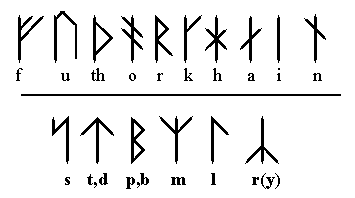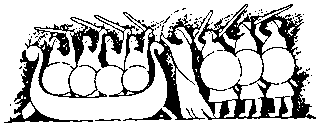The Art of the Norse Language
by Kiera Haefoc
The Norse alphabet is called Futhork (or alternately "Futhark", depending on which of the variety of Norse alphabets you are discussing) after its first six letters. The characters were developed using straight lines which made it easy to carve them into wood or stone. They were used at first for scratching names onto personal belongings or onto memorial stones. With these runes the Vikings left records ranging from tombstones in England, carvings on the statues of a lion in Athens, to a little runestone that was found in the Arctic.
 The Vikings' fascination with words soon went beyond the carving of graffiti on landmarks and setting information on family memorials. Besides the poetry set down in the Elder Edda, the skalds recited either "lying " sagas which were works of fiction, or fact based "family" sagas. An example of the latter is "The Saga of Hrfankel, Priest of Frey", an account of a tenth-century Icelandic murder trial. In these works the skalds invented kenning (literally 'symbols') which is the use of an elaborate metaphor. For example, 'sea stand' is a kenning for a ship and 'hawkfell' is a metaphor for a hand. These were used not only to add flavor and color to the stories, but also as mnemonic devices to help remember lengthy stories.
As with the bards of Ireland, the skalds were respected by royalty and were taken into battle to praise the jarls, the kings and their army. One of the most famous of these skalds was the tenth-century Egil Skallagrimsson who was captured by his blood enemy King Eric Bloodax. Egil composed a work overnight and recited 20 stanzas on the greatness of Eric when he was brought before the king. Bloodax decided that the immortality that he would gain by the skald's poem was a wiser choice than revenge, and so spared his enemy.
Sources:
The Vikings' fascination with words soon went beyond the carving of graffiti on landmarks and setting information on family memorials. Besides the poetry set down in the Elder Edda, the skalds recited either "lying " sagas which were works of fiction, or fact based "family" sagas. An example of the latter is "The Saga of Hrfankel, Priest of Frey", an account of a tenth-century Icelandic murder trial. In these works the skalds invented kenning (literally 'symbols') which is the use of an elaborate metaphor. For example, 'sea stand' is a kenning for a ship and 'hawkfell' is a metaphor for a hand. These were used not only to add flavor and color to the stories, but also as mnemonic devices to help remember lengthy stories.
As with the bards of Ireland, the skalds were respected by royalty and were taken into battle to praise the jarls, the kings and their army. One of the most famous of these skalds was the tenth-century Egil Skallagrimsson who was captured by his blood enemy King Eric Bloodax. Egil composed a work overnight and recited 20 stanzas on the greatness of Eric when he was brought before the king. Bloodax decided that the immortality that he would gain by the skald's poem was a wiser choice than revenge, and so spared his enemy.
Sources:
La Fay, Howard "The Vikings" National Geographic. April 1979, pp. 492-540.
Mack, Maynard, ed. World Masterpieces Volume I. W.W. Norton & Co., Inc.1973.

Back to Early Period #5 |
Back to Early Period Index |
Back to PastTimes


